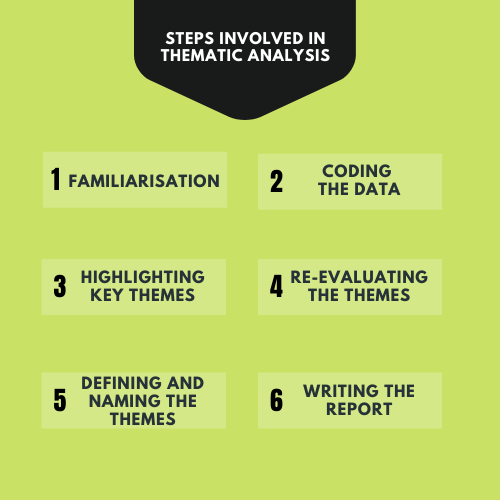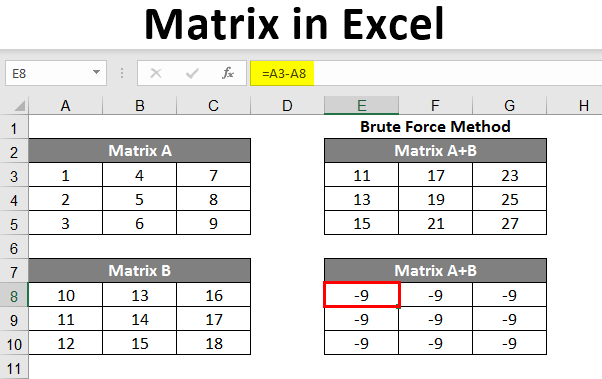Thematic Analysis-Definition, Guide, and Examples
Thematic analysis is a qualitative research technique used to explore patterns of meaning that emerge from qualitative data. In other words, themes or patterns in the data that are not visible at the surface level.
The word ‘thematic’ comes from ancient Greek, which means “of thread.” The idea behind this type of study is that there may be threads connecting different parts into one cohesive whole.
The thematic analysis process is a coding process where researchers generate and analyze themes in qualitative data. By highlighting and categorizing these themes, patterns and trends can be identified, andtheories emerge from the analysis. In thematic analysis, researchers do not test hypotheses but rather build theories from the data.
Qualitative Research
This research approach is inductive, where the researcher begins a study with a problem, a puzzle, or a question to be solved.
Qualitative researchers conduct the empirical investigation guided by the emerging theory from the data. They interpret the results within the context of that specific research problem.
Unlike quantitative research, theoretical sampling (data collected from key informants representing a particular group) is not applied. The researcher collects data from individuals and groups based on questions rather than on specific expertise or availability.
Thematic analysis is one of the common qualitative data analysis methods. It is used to summarize either individual units of analysis or lines of inquiry.
Types of Thematic Analysis
There are three types of thematic analysis, namely reflexive, coding reliability, and codebook.
Reflexive thematic analysis
This data analysis method is used for exploring and examining the researcher’s thinking while studying qualitative data. The analysis is deeply rooted in subjectivity and the perspective of the individual researcher.
The reflexive analysis is usually employed in the early stages of a qualitative study. This is so that researchers can make sense of their thoughts during data gathering. Researchers may also use this process to share their thoughts with colleagues or uncover issues during data analysis.
Coding reliability analysis
This type of thematic analysis is analogous to the coding exercise that is done in quantitative research. This qualitative coding is useful when researchers try to determine the frequency of each theme.
Coding reliability can be used on large or small data sets, but it works best with data already coded into categories.
Codebook thematic analysis
A codebook is a document that outlines the components of a theme. This analysis method describes a theme or a concept in a qualitative study and includes definitions of words and related concepts.
Codebook thematic analysis is useful when researchers are trying to compare themes or concepts. It is also helpful when several coders are coding the same data.
Approaches to Thematic Analysis
The thematic analysis approaches used in qualitative data analysis are semantic, inductive, deductive, and latent.
| • Semantic • Inductive • Deductive • Latent |
Semantic approach
The semantic approach to thematic analysis is used when the researcher begins with a list of potential themes. He then analyzes the data for each theme. In this approach, researchers identify the presence or absence of each theme in the data set.
Inductive approach
With this thematic approach, researchers begin with the data to identify patterns, categories, and themes. The process is somewhat free-flowing, where the researcher may follow different leads during the analysis.
Deductive approach
This approach starts with a preconceived idea about what themes will be present in the data set. Researchers then use the data to prove or disprove their original idea.
Latent approach
The latent approach is used when researchers identify and study themes that are not readily visible in the data. This type of thematic analysis requires an inductive approach to begin. Researchers then move into deductive analysis to find themes that are not apparent.
Advantages of Thematic Analysis
The thematic analysis offers many advantages to researchers. These are some of the benefits:
- Thematic analysis can help to build theory from data. Instead of testing a hypothesis, researchers can build concepts from the data.
- It helps to make sense of complex findings, making it helpful for interpreting large sets of qualitative data.
- It can be used with multiple types of data, including written or spoken words in addition to images.
- Thematic analysis is a flexible approach that can be adjusted based on the preferences of the researcher.
- This data analysis method is useful for presenting findings in a way that other researchers and non-researchers understand.
- It allows researchers to discover important trends in qualitative data.
- Researchers can organize and summarize massive amounts of text and arrive at a more general understanding of the data.
- Thematic analysis can provide researchers with information that is not evident from looking at words and phrases in isolation.
Limitations of Thematic Analysis
- Thematic analysis is a time-consuming process, which makes it difficult to use in large-scale studies. Researchers should always evaluate the usefulness of thematic analysis and consider other data analysis methods before conducting a thematic analysis.
- The thematic analysis process is subjective, making the results hard to reproduce in future studies. This is problematic when researchers are trying to build theories or develop models.
- This analysis is also difficult to apply in quantitative studies, especially when the themes are not derived from variables.
- It is challenging when researchers must test several different themes in one study. This is a common challenge for cross-cultural studies where researchers must compare themes from different cultures.
How to do a Thematic Analysis-Braun and Clarke’s 6 Phases


The thematic qualitative analysis process can be summarized into six phases.
Phase 1: Familiarize with the data
Understanding the collected data is important before beginning any type of thematic analysis. Researchers should always spend time going over the data and familiarizing themselves with the different themes in the data.
It is helpful when researchers read the data in its entirety at least once and then focus on specific parts that may be relevant to their study. This first phase will set the pace for the subsequent phases.
Phase 2: Open coding
During this phase, researchers begin to categorize the data and identify concepts. It is important to define words and create a codebook for the data. Researchers should actively copy and paste excerpts from the data into the codebook as they go along. This process can be done manually or with technology.
This phase is sometimes called the “saturation” phase. By the end of the phase, researchers have created their initial codes and identified several themes.
Phase 3: Axial coding
During this phase, researchers are generating themes and identifying relationships between themes which results in higher-level codes. It is important to create a matrix as a guide during this stage of analysis.
Once the relationship between codes is understood, researchers may create a matrix that links all the themes. This is also called the theme development stage.
Phase 4: Theme review
At this stage, the themes identified in the third phase are reviewed and analyzed. Researchers may identify patterns and relationships between themes at this phase. They can also compare the data to other studies that utilize a similar approach. This comparison helps in validating the data analysis results even though studies differ in many ways.
Phase 5: Theme definition and naming
This phase involves naming all the themes and defining them. Researchers should also determine the relationship between themes at this phase.
After setting the themes, researchers determine which themes are dominant within the data and need further development. These themes can also be compared to the literature on the subject.
Researchers also determine if any of the themes can be combined or eliminated from the analysis.
Phase 6: Write up and interpretation
The final phase is the actual writing of the study. Researchers should write a summary paragraph about all of the themes and describe them in detail.
Themes can be compared to other studies and theories about the subject matter. It is important to include a section of the results on how the themes were derived from the data.
Data Validity in Thematic Qualitative Analysis
Thematic qualitative analysis is subjective by nature. This means that there is no right answer; the result depends on the individual conducting the analysis.
Thematic analysis should be considered a tool to help researchers understand their data. It should not be used as the sole method of interpretation.
The researchers ensure data validity in the following ways:
| • Use reliable Software • Ensure data transparency • Use multiple coding methods • Be consistent • Avoid over-ambiguity • Do thorough data review • Understand the limitations • Conduct a sensitivity analysis |
Using reliable software
Thematic analysis software allows researchers to quickly and efficiently code large amounts of data. Some programs can help organize the themes, which can aid in data validity.
When researchers are familiar with coding software, it ensures that all themes are reliable and valid. It can also help them remain consistent in their approach across different data sets.
Thematic qualitative analysis software can vary greatly, so some researchers use multiple tools to code their data. This may alleviate concerns about software errors and can help provide a complete picture of the data.
Researchers should be aware of the limitations of any software. For example, some tools can be too rigid and limit interpretation.
Ensuring transparency in data
Transparency ensures that researchers are as open and honest as possible about their data. It also ensures that the themes do not just reflect what the researcher believes is most important.
Transparency in data is ensured by allowing others to review the entire process of thematic qualitative analysis. For example, they can look at the initial research questions, codes, themes, and relationships. This can be done with peers or other researchers to aid in ensuring validity.
Researchers should also consider the limitations of transparency. Promoting transparency can lead to details and nuance being lost in interpretation. These limitations impact how the researcher analyzes the data.
Using multiple methods to code the data
Data coding should not be a single-step process. Instead, researchers should use multiple methods to analyze their data. This can include both qualitative and quantitative coding techniques.
Researchers can use multiple coding approaches to ensure that they are as objective as possible. It may also help them compare the results of different types of coding. Researchers may also use the different types of coding across different stages of the analysis process.
Being consistent
Researchers should be consistent when coding and interpreting the data across different methods and data sets. This consistency ensures that the themes are valid and can be compared to other data.
Consistency is also important because it ensures that the researchers stay true to their research questions. If themes are not compared across data sets, the results may be skewed or incomplete.
Avoiding over-ambiguity
Ambiguity is a major concern in thematic analysis because it can affect the reliability and validity of themes. Researchers may discover too many themes, which can threaten data validity.
When researchers code large amounts of data, they often use multiple codes to describe the same theme. This is part of the coding process and is typically not a major concern.
Avoiding ambiguity can be assisted by using multiple methods of analysis. Researchers may also refer to the research questions when coding and interpreting data.
When moderate ambiguity is seen as a valuable part of the data, it helps identify previously considered or reported themes.
Doing a thorough data review
Researchers should thoroughly review the data and write a detailed description of each theme before comparisons are made. All of the data should be included in these descriptions.
When researchers produce thorough descriptions, others can more accurately and completely replicate the process and reproduce the results.
Being aware of limitations within themes
Researchers should be aware of the limits to their interpretations and results. It is essential to remain reflexive throughout the process.
Limitations may include how closely themes align with the original research questions. If the researcher is biased by their social location or experiences, themes may not accurately represent the research questions.
Conducting a sensitivity analysis
Sensitivity analysis is a technique in which researchers examine the impact of coding decisions on their data. This can ensure that the codebook is balanced and reflects all of the data.
By reviewing every decision and its impact on the analysis, researchers can make any necessary adjustments. It also ensures that the themes reflect only a few data points but represent the entire data set.
Common Tools for Doing a Thematic Analysis
Many tools assist researchers in performing thematic analysis. They include:
Matrices


Matrices are a good way to organize the data. They contain rows and columns corresponding to different themes or codes that researchers have identified in the data. The matrix can also include codes that are not themes.
Researchers use these matrices to compare the data and identify themes. They can also include notes about specific codes or themes. This can be particularly helpful for organizing complex data sets. However, these notes can also lead to ambiguity if not used carefully.
Timeline
A timeline helps researchers map out a sequence of events. They can use these timelines to identify when certain themes emerge and how they change over time.
Timelines are useful in revealing how events are related to certain themes that emerge from the data. Researchers position themes better once they establish a pattern using the established timelines.
Connecting concepts
This method links different codes or themes together, which assists in identifying themes. For example, this method can be helpful when two codes are closely connected. It’s also applicable when there is one main theme with several subthemes.
Connecting concepts also assists researchers in identifying a theme that emerged from data but was not included in the research questions. This can be particularly helpful when researchers are working with rich data.
Visualization
Visualization can be a very helpful way to identify themes in the data. For example, researchers can use chart generation tools to create charts. They can also use mapping software to create maps based on themes in the data.
Visualization can assist researchers in mapping out relationships and identify themes and patterns in the data. For example, the maps may show where certain themes are most prominent or most closely related.
Thematic software applications
There are many qualitative data analysis software packages on the market. Some of these applications allow for thematic analysis and support the process with easy-to-use technology.
Online coding tools
Online coding tools allow the researcher to copy and paste passages from the text directly into the code window. The researcher can then organize codes within a cloud and save them for later use.
Examples of online coding tools include:
| • DT • R • DITONI • Coding XL |
DT (Developed by IBM)
This software was created by the same researchers who developed NVivo. It is compatible with NVivo and allows the researcher to copy text passages directly into the code window.
The DT website has a searchable library of tutorials, helpful videos, and a community discussion board.
R (open-source software)
It is an open-source coding system that is customizable to the specific research question. The user must have coding knowledge to use it effectively.
DITONI (Data Integration for Thematic Nominal Inference)
This tool allows researchers to analyze text from the comfort of their browser. Users can copy passages from texts into the coding window and manipulate them.
CodingXL
It is a program that allows researchers to integrate NVivo and Excel files and create a single, searchable database. There is also a free trial option for those who want to try it out before starting a research project.
Tips on How to Find Themes in Your Qualitative Data
The following tips can help find themes in qualitative data:
- Find thematic patterns within the data. These patterns develop into themes.
- Examine outliers or discrepancies
- Look for relationships between words, phrases, and concepts
- Refer to the literature
- Apply codes to phrases or words that may not easily fit into any of the existing themes
- Don’t discard any data
- Repeat steps 2-5 until all the data has been coded
- Once all the data has been coded, return to the raw data and look for new themes or patterns
- Try not to search for themes within the data
- Let the thematic patterns emerge from the data
- Consider using a conceptual or higher-order coding system
What Necessitates Conducting Thematic Analysis?
A thematic analysis might be necessary if a researcher wants to:
- Uncover the themes, patterns, or structures of the data and give a detailed analysis.
- Explore how people use words within a specific context to communicate their experiences and make sense of the world around them.
- Develop a deeper understanding of the people who are being studied.
- Find underlying meanings in the data. This is particularly helpful in looking for themes that are not available on the surface level of language use. For example, some people may avoid talking about certain topics, such as sexuality or mental health. This information might become visible through a thematic analysis.
- Compare the findings of two or more studies.
- Conclude the data. This can help answer specific research questions or develop a theory around a phenomenon.
Thematic Analysis Examples
Example 1:
A researcher is interested in examining the themes of “powerlessness, alienation, and lack of autonomy among micro-entrepreneurs.” The themes that emerged from this research included “sense of time poverty,” “loss of dignity and respect,” and “welfare recipients turned entrepreneurs.”
Out of this study, some interesting patterns emerged. For example, “sense of time poverty” refers to how the subjects in the research felt they no longer had the time they once had to devote to their families, hobbies, etc. This is different from “lack of autonomy,” which dealt with how the micro-entrepreneurs felt they had no authority over their businesses.
The relationships between words, phrases, and concepts can be seen in the themes “welfare recipients turned entrepreneurs” and “sense of time poverty.” In this study, the participants described their former welfare recipients as becoming entrepreneurs. This happened by turning to micro-enterprises for financial support.
Example 2:
A researcher is interested in exploring themes of motherhood related to teenage mothers. After completion, the researcher found two major themes: the first theme was “discovery of motherhood,” and the second theme was “the transition from being a teen to being a young adult.”
All of the collected data in this research led to the emergence of two overarching categories: “discovery of motherhood” and “transition from being a teen to being a young adult.”
The discovery of motherhood refers to the participants’ realization that they truly were mothers. This differed from the second theme, “transition from being a teen to a young adult.’ The latter was more about figuring out how their lives changed once they became mothers.
There’s a relationship between the two themes in that the participants described how they discovered motherhood after becoming pregnant. They also talked about their transition to adulthood while raising their children.
Example 3
A researcher is interested in exploring the theme of guardianship and its relation to being a scholarship recipient. After completion, the researcher found two overarching themes: “the conception of scholarship” and “mutual obligation.”
The first theme is the conception of scholarship, and this refers to how scholarship recipients view themselves as recipients. The second theme, “mutual obligation,” speaks more about the obligations that the scholars believe they have to those who provide them with scholarships.
In this example, both themes are related. The scholarship recipients view themselves as recipients of aid and understand that they have responsibilities to fulfill.
Example 4
A researcher is interested in exploring themes of “race, gender, and their effect on the criminal justice system.” After completion, two major themes emerged.
The first theme is “race as a factor,” which relates to how race influences the criminal justice system. The second major theme was “gender as a factor,” which relates to how gender influences the criminal justice system.
In this research, two major themes spoke about how race and gender affect the criminal justice system differently. Themes are seen as individual pieces of data that relate to a larger concept or idea.
The relationship between the two themes is that they look at how race and gender affect the criminal justice system. For example, “race as a factor” discusses how race influenced the criminal justice system. Also, “gender as a factor” discusses how gender affects the criminal justice system.
Example 5
A researcher is interested in exploring themes of “poverty and illness.” After completion, two major themes emerged.
The first theme is “long-term poverty,” which relates to how poverty is linked with poor health. The second major theme was “financial insecurity,” which is about how financial stress can lead to many issues, including poor health.
For this study, both themes are related as they look at the relationship between poverty and illness. For example, “long-term poverty” looks at how poverty is linked with poor health, whereas “financial insecurity” discusses how financial stress has caused illness.
Summary
Thematic analysis is a research technique used to identify and summarize patterns in qualitative data. Inductive, semantic, latent, and deductive analysis are the various approaches to thematic analysis. Each approach has its steps for identifying and summarizing themes within the data.
There is no right or wrong way to do a thematic analysis, and it can take a lot of time, patience, and skill. Completing a thematic analysis involves many steps to ensure the validity and trustworthiness of the results. There are also many different available software applications to help assist with completing a thematic analysis.
A common misconception about thematic analysis is that it only applies to textual material; however, you can also use it with visual content like photographs or videos!


I‘m a freelance content and SEO writer with a passion for finding the perfect combination of words to capture attention and express a message. I create catchy, SEO-friendly content for websites, blogs, articles, and social media. My experience spans many industries, including health and wellness, technology, education, business, and lifestyle. My clients appreciate my ability to craft compelling stories that engage their target audience, but also help to improve their website’s search engine rankings. I’m also an avid learner and stay up to date on the latest SEO trends. I enjoy exploring new places and reading up on the latest marketing and SEO strategies in my free time.






